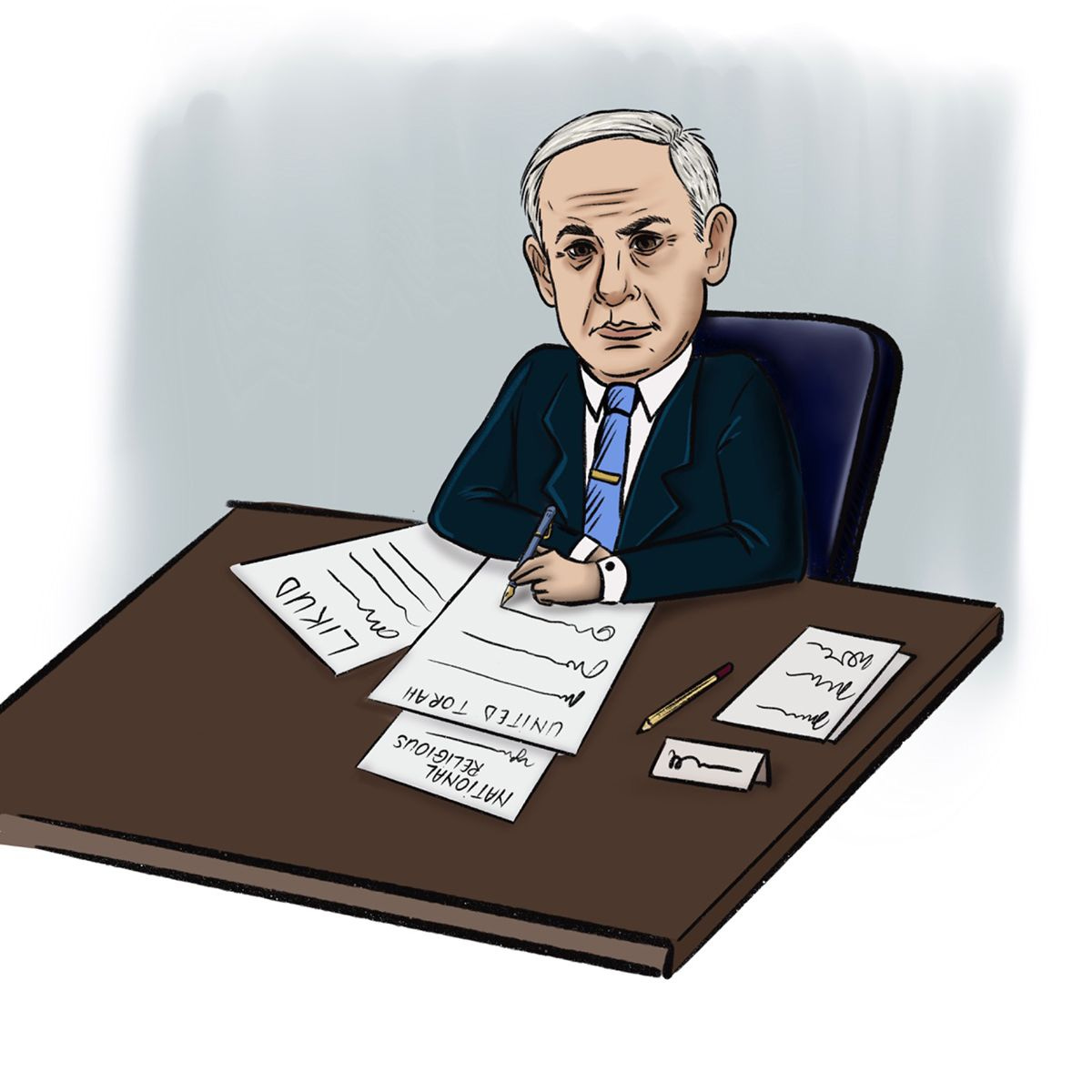The Israeli Election Guide for the Perplexed, Part 3
In Part 3 of our Israeli Election Guide Vivian Bercovici explains how former PM Benjamin Netanyahu engineered a merger between far-right parties

I. THE SIT DOWN IN CAESAREA
A few weeks ago, Benjamin Netanyahu invited Itamar Ben Gvir and Bezalel Smotrich to visit at his seaside mansion in Caesarea, a wealthy enclave between Tel Aviv and Haifa.
It surely was not for a round of golf at the only course in Israel, a stone’s throw from his home. No. Benjamin Netanyahu was fed up with their petulant squabbles. He summoned them for a “sit-down” so that he could help them understand clearly that they were at the forefront of the imminent moral destruction of Israel.
Only a Likud-led government, supported by the ultra-Orthodox Haredim as well as the hard-right religious nationalist parties (helmed by Smotrich and Ben Gvir), would ensure that the “values” presumably shared by them and Likud would prevail. Otherwise, he almost certainly reminded them, Israel could end up with another “left-wing” government supported by Arabs, or worse.
Of course, I was not in the room but it doesn’t take much to imagine what was said.

II. ITAMAR BEN GVIR
Itamar Ben Gvir, about whom we have written previously, is a 46-year-old husband and father of five who lives in a heavily guarded Jewish enclave in Hebron. The several thousand Jewish residents tend to be on the religiously and politically hard-right end of the spectrum. Some consider them to be extremists.
Ben Gvir is extreme.
He is a Kahanist – disciple of the teachings of the late Rabbi Meir Kahane – who was murdered in 1990 in NY and also has the distinction of having been prohibited from taking a seat in the Knesset pursuant to a law targeting his activity which purported to ban proponents of hatred from joining the legislative chamber.
There seems to be a significant uptick in Ben Gvir’s appeal in recent years, particularly to younger people. His party – Jewish Power (“Otzma Yehudit”) – is extreme. He supports annexation of the West Bank and promotes a policy of deporting Arabs who he would deem to be disloyal to the state. Two decades ago, he would have been untouchable in the Israeli political system. Today, the aspiring prime minister entices him.

In the runup to last Thursday – September 15, a momentous day in the current election cycle – Ben Gvir was posing a serious threat to Smotrich. Polls consistently affirmed that if the two ran together they would control more mandates than if they remained separate. Furthermore, if Ben Gvir was leader their performance would be stronger than if Smotrich was number one. That must have stung.
Ironically, if they run separately, Ben Gvir’s party is the one that may not cross the threshold. The clear takeaway is that Ben Gvir is regarded as the stronger leader of the two but if forced to choose many voters prefer the Religious Zionism party brand. It’s a touch softer than Ben Gvir’s brand.
Ben Gvir and Smotrich reportedly loathe one another. But it is in both their political interests to run a combined slate with merged parties.
III. BEZALEL SMOTRICH
The other half of the equation is Bezalel Smotrich; husband, father of seven, living in the West Bank community/settlement of Kedumim.
Like Ben Gvir he is bullish on annexation of the West Bank as well as settlement expansion. It used to be that Israelis adhering to this ideology – Religious Nationalism – were ideologically driven but more pragmatic.
They are easily distinguished on the street from Haredim by their attire. Men trim their beards and wear crocheted and colorful kippot. Their clothing is more varied and western, unlike the head-to-toe dark or black garb of Haredi Jews.

Women, too, dress more fashionably and have developed some big statement head coverings that draw attention. Theirs is a community in which Jewish law prevails but is balanced with accommodations for the real world – like working, earning a living and participating in either army or national service.
Many Israelis tend to focus on the problems posed by the Haredi community in Israel and pay less attention to the “Hardalim,” as the National Religious supporters are known colloquially.
But the Hardal population is significant, growing and highly motivated, and adheres to values that prioritize Jewish law over democratic norms. In this respect they align with the Haredi constituency and present a significant challenge to the segment of the Israeli population that is more traditional or secular and holds liberal democracy in high esteem.
IV. BENJAMIN NETANYAHU
For more than a year now, the redoubtable former and longest serving Israeli PM, Benjamin Netanyahu, has been cooling off on the Opposition bench. He’s had a productive year, penning his “Life Story,” due out in mid-November, and, clearly, planning a return to the top job. Steadfastly.
To pull that off he must have the full force of the ultra-Orthodox and National Religious vote behind him. He cannot afford to waste or lose a single seat to ego and squabbles.
And, so, in advance of the lists being published, he invited Ben Gvir and Smotrich for a chat to his seaside villa.

V. THE BIG STORY OF THE LISTS
Israeli election law stipulates that 48 days prior to an election occurring, all parties intending to run candidates must submit a list of party members running, in order of descendance, to the Central Elections Committee.
Some party lists – like Yair Lapid’s Yesh Atid – are determined in a closed session. Likud, on the other hand, holds primary contests where members intending to run for office are placed on a ballot which goes to the general party membership for a vote.
Interestingly, in the Likud primary held on August 10, more than a few highly regarded and prominent Likudniks – among them former Prisoner of Zion Yuli Edelstein, who ranked #2 – dropped precipitously, as Edelstein did to #16. (He placed 18th on the final list due to two seats reserved for Netanyahu to assign to preferred candidates.) Tzachi Hanegbi, from Likud royalty, placed so low he is unlikely to snag a seat.
Edelstein (and some lesser-known MKs) was clearly punished for being perceived to have been disloyal to Bibi during the last year, as he cooled his heels on the Opposition bench. He stated openly that if Bibi stepped down as leader, he was ready to run for the top job. In Likud, where blind loyalty is the only currency, this constituted a major indiscretion and Edelstein was disdained and rewarded, in kind.
Netanyahu is a formidable adversary and brilliant tactician, reflected in the minor miracle he pulled off on List Day.
His major triumph was in convincing Smotrich and Ben Gvir to choke on their mutual dislike and join forces to maximize the National Religious and Likud vote. I hesitate to call it the “right-wing” bloc, as most do, because their alliance really has nothing to do with anything right wing. Likud is determined to save Bibi and return to power, at any cost. And Smotrich and Ben Gvir uniting improves that possibility, significantly, as not a single vote for either of them will be wasted.

A similar victory was also scored by Bibi with the Haredi United Torah Judaism parties. An uneasy partnership between the Hasidic Agudat Israel and Lithuanian Degel HaTorah parties, these groups have had a long-festering conflict that nearly caused them to split, with the near certainty that at least one of them would not make it into the Knesset.
So, Bibi promised them that he will give them whatever funds required to allow them to continue to operate yeshivas that do not teach any secular subjects, like math, science, English or basic modern Hebrew literacy. (In most ultra-Orthodox schools, studies are conducted in Yiddish and Hebrew, with an emphasis on ancient texts. Literacy in the modern spoken and written language is not emphasized.) Basically, Bibi promised to raid the treasury so that the Haredim may carry on living in their autonomous mini-state within a state. He bought their support. This has nothing to do with being right, left, centrist or upside down.
That’s the Big Story of The Lists.
VI. THE BOTTOM LINE… FOR NOW
The publication of the lists is the clearest signal to the public as to what has gone down in the backrooms for the last two and a half months since the election was called. And, until E-Day, they are cast in stone. No changes to lists or party alliances allowed, by law.
So, we have confirmed what we’ve always known: that the Haredi parties care only about financing and preserving their state-sponsored entitlements and autonomy. And we have confirmed that Likud will do anything to win, including throwing more money at this demographic and emboldening them to demand more. Whether it is in the state’s interest to do so is irrelevant. All that matters is Likud returning to power.
The only value that Bibi is preserving is the importance of him staying in power. He has no economic platform (as he may have had 10 or 15 years back). And his outright purchase of the Haredi endorsement and vote bodes disaster for Israel.
On the margins, but in many ways no less significant for the election outcome, the Arab Joint List – an uneasy coalescence of three parties with wildly different agendas – saw one party peel off to go solo. The two remaining – Aymen Oden’s Hadash and Ahmed Tibi’s Ta’al parties – will likely make it into the Knesset running together, but Balad – running alone – almost certainly will not. And, this blow comes one election after Mansour Abbas’ Ra’am party left the Joint List to go alone – causing a seismic shift in Israeli politics.
The Arab vote is expected to stay at home for the most part, meaning that any possible support from this bloc in support of Lapid is significantly reduced.
Which segues nicely into the last blow to Lapid and his allies. Unlike Bibi, Lapid was unable to convince the two diminished remnants of the old, dominant left wing in Israel – Meretz and Labor – to unite. Each party is flirting with oblivion, hovering too close for comfort by the threshold. Should one fail to pass it will ensure that the Haredim, the Hardalim and the Likud dominate Israeli political life for some time to come.
To be continued…


